How Does Flooding Influence Intra-Urban Mobility? The Case of Accra
Abstract
:1. Introduction
1.1. Flooding and Urban Mobility
1.2. Vulnerability of Road Infrastructure
1.3. Objectives
2. Materials and Methods
2.1. City-Scale Analysis (A1 + A2)
2.1.1. Survey: Mobility and Travel Behaviour
2.1.2. Road-Specific Traffic Volumes
2.1.3. Flood Model and Precipitation Levels
2.1.4. Network Hotspots Causing Mobility Loss
2.1.5. Impact on Population
2.2. Local-Scale Analysis
2.2.1. Access to Main Roads—Impacted Areas
2.2.2. Hotspots Causing Local Mobility Loss
3. Results
3.1. Mobility Survey Results
3.2. Hotspots Causing Mobility Loss (City Scale)
3.2.1. Transport Model
3.2.2. Intersections of High-Volume Roads and Bluespot Locations
3.3. Spatial Distribution of Mobility Loss (City Scale)
3.4. Spatial Distribution of Mobility Loss (Local Scale)
3.5. Hotspots Causing Mobility Loss (Local Scale)
4. Discussion
4.1. Application of the Mobility Survey
4.2. Validity of Transport Model
4.3. Validity of Flood Screening Data
4.4. City-Scale Analysis
4.5. Local-Scale Analysis
4.6. Policy and Planning Implications
5. Conclusions
Author Contributions
Funding
Institutional Review Board Statement
Informed Consent Statement
Data Availability Statement
Conflicts of Interest
References
- Amankwaa, E.F.; Gough, K.V. ‘We are at the mercy of the floods!’: Extreme weather events, disrupted mobilities, and everyday navigation in urban Ghana. Singap. J. Trop. Geogr. 2023, 44, 235–254. [Google Scholar] [CrossRef]
- Dong, S.; Esmalian, A.; Farahmand, H.; Mostafavi, A. An integrated physical-social analysis of disrupted access to critical facilities and community service-loss tolerance in urban flooding. Comput. Environ. Urban Syst. 2020, 80, 101443. [Google Scholar] [CrossRef]
- Kermanshah, A.; Derrible, S. Robustness of road systems to extreme flooding: Using elements of GIS, travel demand, and network science. Nat. Hazards 2016, 86, 151–164. [Google Scholar] [CrossRef]
- Martins, M.C.d.M.; Rodrigues da Silva, A.N.; Pinto, N. An indicator-based methodology for assessing resilience in urban mobility. Transp. Res. Part D Transp. Environ. 2019, 77, 352–363. [Google Scholar] [CrossRef]
- Papilloud, T.; Keiler, M. Vulnerability patterns of road network to extreme floods based on accessibility measures. Transp. Res. Part D Transp. Environ. 2021, 100, 103045. [Google Scholar] [CrossRef]
- Zhang, M.; Xu, M.; Wang, Z.; Lai, C. Assessment of the vulnerability of road networks to urban waterlogging based on a coupled hydrodynamic model. J. Hydrol. 2021, 603, 127105. [Google Scholar] [CrossRef]
- Ghana Statistical Service. Ghana 2021 Population and Housing Census. Volume 1, Preliminary Report. 2021. Available online: https://census2021.statsghana.gov.gh/gssmain/fileUpload/reportthemelist/PRINT_COPY_VERSION_FOUR%2022ND_SEPT_AT_8_30AM.pdf (accessed on 15 January 2023).
- Møller-Jensen, L.; Kofie, R.Y.; Allotey, A.N.M. Measuring accessibility and congestion in Accra. Nor. Geogr. Tidsskr. Nor. J. Geogr. 2012, 66, 52–60. [Google Scholar] [CrossRef]
- Gaisie, E.; Kim, H.M.; Han, S.S. Accra towards a city-region: Devolution, spatial development and urban challenges. Cities 2019, 95, 102398. [Google Scholar] [CrossRef]
- Douglas, I.; Alam, K.; Maghenda, M.; McDonnell, Y.; McLean, L.; Campbell, J. Unjust waters: Climate change, flooding and the urban poor in Africa. Environ. Urban. 2008, 20, 187–205. [Google Scholar] [CrossRef]
- Douglas, I. Flooding in African cities, scales of causes, teleconnections, risks, vulnerability and impacts. Int. J. Disaster Risk Reduct. 2017, 26, 34–42. [Google Scholar] [CrossRef]
- Møller-Jensen, M.; Agergaard, J.; Andreasen, M.H.; Oteng-Ababio, M.; Yankson, P.W.K. Urban expansion and consolidation in Accra’s peripheries An examination of the entwinement of development and flood risk in four settlements. Dep. Geosci. Nat. Resour. Manag. Univ. Copenhagen 2020, 109, 109. [Google Scholar]
- Andreasen, M.H.; Agergaard, J.; Allotey, A.N.M.; Møller-Jensen, L.; Oteng-Ababio, M. Built-in Flood Risk: The Intertwinement of Flood Risk and Unregulated Urban Expansion in African Cities. Urban Forum 2022, 34, 385–411. [Google Scholar] [CrossRef]
- Amoako, C.; Inkoom, D.K.B. The production of flood vulnerability in Accra, Ghana: Re-thinking flooding and informal urbanisation. Urban Stud. 2017, 55, 2903–2922. [Google Scholar] [CrossRef]
- Tramblay, Y.; Villarini, G.; Khalki, E.M.; Gründemann, G.; Hughes, D. Evaluation of the Drivers Responsible for Flooding in Africa. Water Resour. Res. 2021, 57, e2021WR029595. [Google Scholar] [CrossRef]
- Gough, K.; Yankson, P.; Wilby, R.L.; Amankwaa, E.F.; Abarike, M.A.; Codjoe, S.; Griffiths, P.; Kasei, R.; Kayaga, S.; Nabilse, C. Vulnerability to extreme weather events in cities: Implications for infrastructure and livelihoods. J. Br. Acad. 2019, 7, 155–181. [Google Scholar] [CrossRef]
- Andreasen, M.H.; Agergaard, J.; Møller-Jensen, L.; Oteng-Ababio, M.; Yiran, G.A.B. Mobility Disruptions in Accra: Recurrent Flooding, Fragile Infrastructure and Climate Change. Sustainability 2022, 14, 3790. [Google Scholar] [CrossRef]
- Tatah, L.; Foley, L.; Oni, T.; Pearce, M.; Lwanga, C.; Were, V.; Assah, F.; Wasnyo, Y.; Mogo, E.; Okello, G.; et al. Comparing travel behaviour characteristics and correlates between large and small Kenyan cities (Nairobi versus Kisumu). J. Transp. Geogr. 2023, 110, 103625. [Google Scholar] [CrossRef]
- Andreasen, M.H.; Møller-Jensen, L. Access to the city: Mobility patterns, transport and accessibility in peripheral settlements of Dar es Salaam. J. Transp. Geogr. 2017, 62, 20–29. [Google Scholar] [CrossRef]
- Jenelius, E.; Mattsson, L.-G. Road network vulnerability analysis: Conceptualization, implementation and application. Comput. Environ. Urban Syst. 2015, 49, 136–147. [Google Scholar] [CrossRef]
- Balijepalli, C.; Oppong, O. Measuring vulnerability of road network considering the extent of serviceability of critical road links in urban areas. J. Transp. Geogr. 2014, 39, 145–155. [Google Scholar] [CrossRef]
- Sohn, J. Evaluating the significance of highway network links under the flood damage: An accessibility approach. Transp. Res. Part A Policy Pract. 2006, 40, 491–506. [Google Scholar] [CrossRef]
- Wiśniewski, S.; Borowska-Stefańska, M.; Kowalski, M.; Sapińska, P. Vulnerability of the accessibility to grocery shopping in the event of flooding. Transp. Res. Part D Transp. Environ. 2020, 87, 102510. [Google Scholar] [CrossRef]
- Ganin, A.; Kitsak, M.; Marchese, D.; Keisler, J.M.; Seager, T.; Linkov, I. Resilience and efficiency in transportation networks. Sci. Adv. 2017, 3, e1701079. [Google Scholar] [CrossRef] [PubMed]
- Kasmalkar, I.G.; Serafin, K.A.; Miao, Y.; Bick, I.A.; Ortolano, L.; Ouyang, D.; Suckale, J. When floods hit the road: Resilience to flood-related traffic disruption in the San Francisco Bay Area and beyond. Sci. Adv. 2020, 6, eaba2423. [Google Scholar] [CrossRef]
- Morelli, A.B.; Cunha, A.L. Measuring urban road network vulnerability to extreme events: An application for urban floods. Transp. Res. Part D Transp. Environ. 2021, 93, 102770. [Google Scholar] [CrossRef]
- Singh, P.; Sinha, V.S.P.; Vijhani, A.; Pahuja, N. Vulnerability assessment of urban road network from urban flood. Int. J. Disaster Risk Reduct. 2018, 28, 237–250. [Google Scholar] [CrossRef]
- Maze, T.H.; Agarwal, M.; Burchett, G. Whether Weather Matters to Traffic Demand, Traffic Safety, and Traffic Operations and Flow. J. Transp. Res. Board 2006, 1948, 170–176. [Google Scholar] [CrossRef]
- Pregnolato, M.; Ford, A.; Wilkinson, S.M.; Dawson, R.J. The impact of flooding on road transport: A depth-disruption function. Transp. Res. Part D Transp. Environ. 2017, 55, 67–81. [Google Scholar] [CrossRef]
- Shah, S.M.H.; Mustaffa, Z.; Martinez-Gomariz, E.; Kim, D.K.; Yusof, K.W. Criterion of vehicle instability in floodwaters: Past, present and future. Int. J. River Basin Manag. 2019, 19, 1–23. [Google Scholar] [CrossRef]
- Stamos, I.; Salanova Grau, J.M.; Mitsakis, E.; Aifadopoulou, G. Modeling Effects of Precipitation on Vehicle Speed: Floating Car Data Approach. Transp. Res. Rec. J. Transp. Res. Board 2016, 2551, 100–110. [Google Scholar] [CrossRef]
- Mitsakis, E.; Stamos, I.; Diakakis, M.; Salanova Grau, J.M. Impacts of high-intensity storms on urban transportation: Applying traffic flow control methodologies for quantifying the effects. Int. J. Environ. Sci. Technol. 2014, 11, 2145–2154. [Google Scholar] [CrossRef]
- Diakakis, M.; Boufidis, N.; Salanova Grau, J.M.; Andreadakis, E.; Stamos, I. A systematic assessment of the effects of extreme flash floods on transportation infrastructure and circulation: The example of the 2017 Mandra flood. Int. J. Disaster Risk Reduct. 2020, 47, 101542. [Google Scholar] [CrossRef]
- Chen, X.-Z.; Lu, Q.-C.; Peng, Z.-R.; Ash, J.E. Analysis of Transportation Network Vulnerability under Flooding Disasters. Transp. Res. Rec. J. Transp. Res. Board 2015, 2532, 37–44. [Google Scholar] [CrossRef]
- Boeing, G. OSMnx: New methods for acquiring, constructing, analyzing, and visualizing complex street networks. Comput. Environ. Urban Syst. 2017, 65, 126–139. [Google Scholar] [CrossRef]
- Balstrøm, T.; Crawford, D. Arc-Malstrøm: A 1D hydrologic screening method for stormwater assessments based on geometric networks. Comput. Geosci. 2018, 116, 64–73. [Google Scholar] [CrossRef]
- Trepekli, K.; Balstrøm, T.; Friborg, T.; Fog, B.; Allotey, A.N.; Kofie, R.Y.; Møller-Jensen, L. UAV-borne, LiDAR-based elevation modelling: A method for improving local-scale urban flood risk assessment. Nat. Hazards 2022, 113, 423–451. [Google Scholar] [CrossRef]
- Kwaku, X.K.; Duke, O. Characterization and frequency analysis of one day annual maximum and two to five consecutive days’ maximum rainfall of Accra, Ghana. RPN J. Eng. Appl. Sci. 2007, 2, 27–31. [Google Scholar]
- Shu, C.; Xia, J.; Falconer, R.A.; Lin, B. Incipient velocity for partially submerged vehicles in floodwaters. J. Hydraul. Res. 2011, 49, 709–717. [Google Scholar] [CrossRef]
- Esson, J.; Gough, K.V.; Simon, D.; Amankwaa, E.F.; Ninot, O.; Yankson, P.W.K. Livelihoods in motion: Linking transport, mobility and income-generating activities. J. Transp. Geogr. 2016, 54, 34–40. [Google Scholar] [CrossRef]
- Melbye, D.C.; Møller-Jensen, L.; Andreasen, M.H.; Kiduanga, J.; Busck, A.G. Accessibility, congestion and travel delays in Dar es Salaam—A time–distance perspective. Habitat Int. 2015, 46, 178–186. [Google Scholar] [CrossRef]

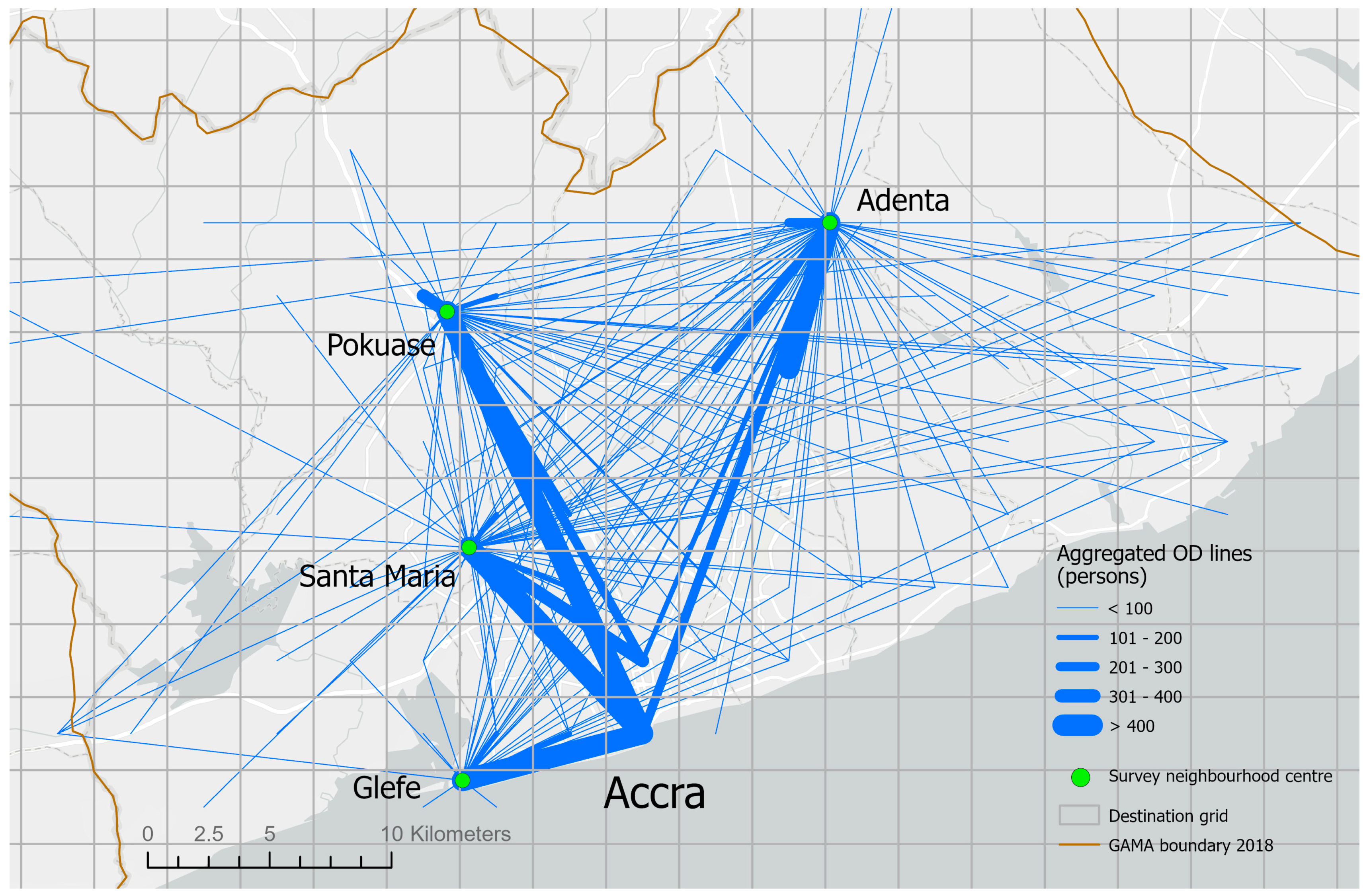
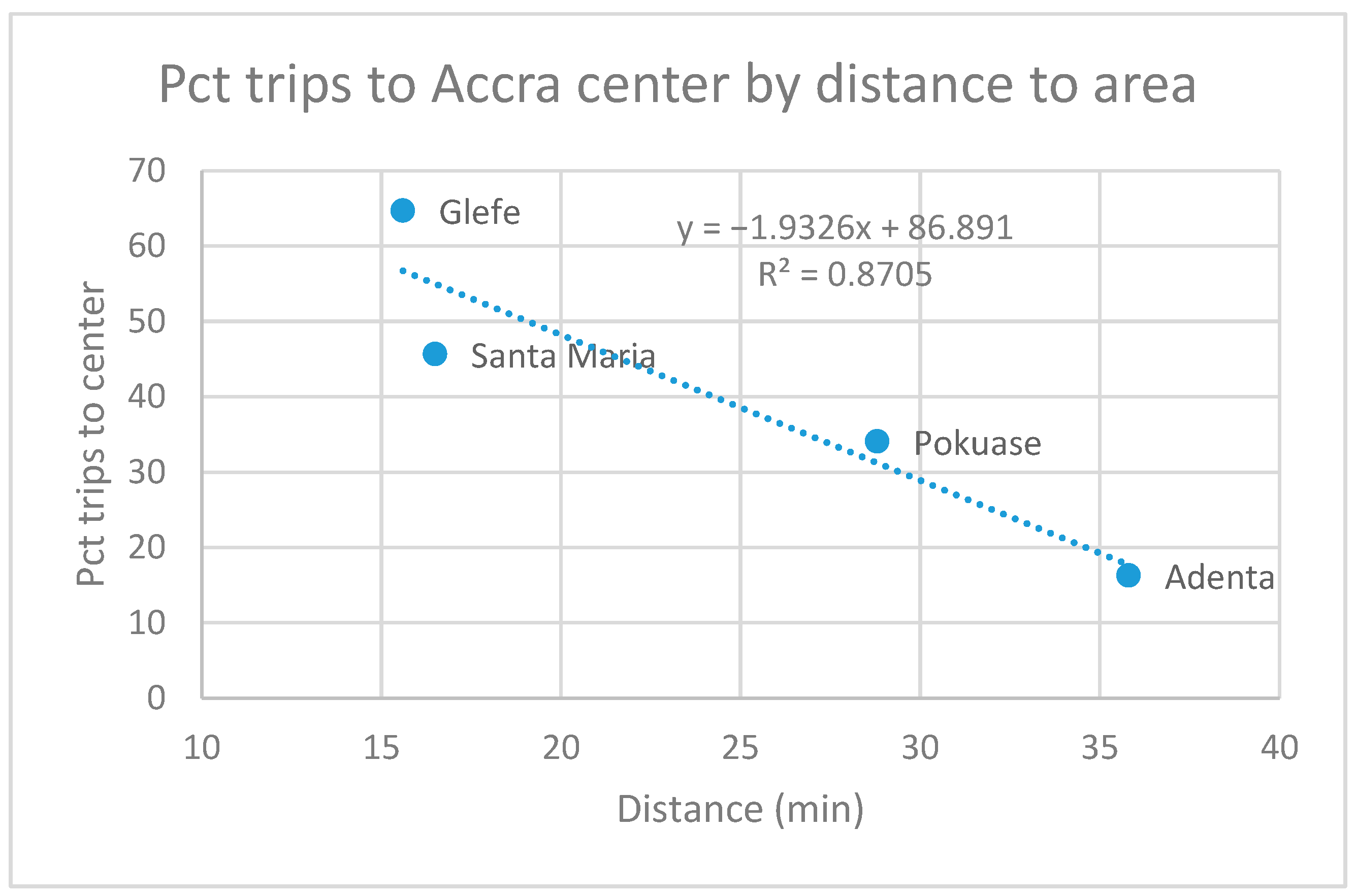
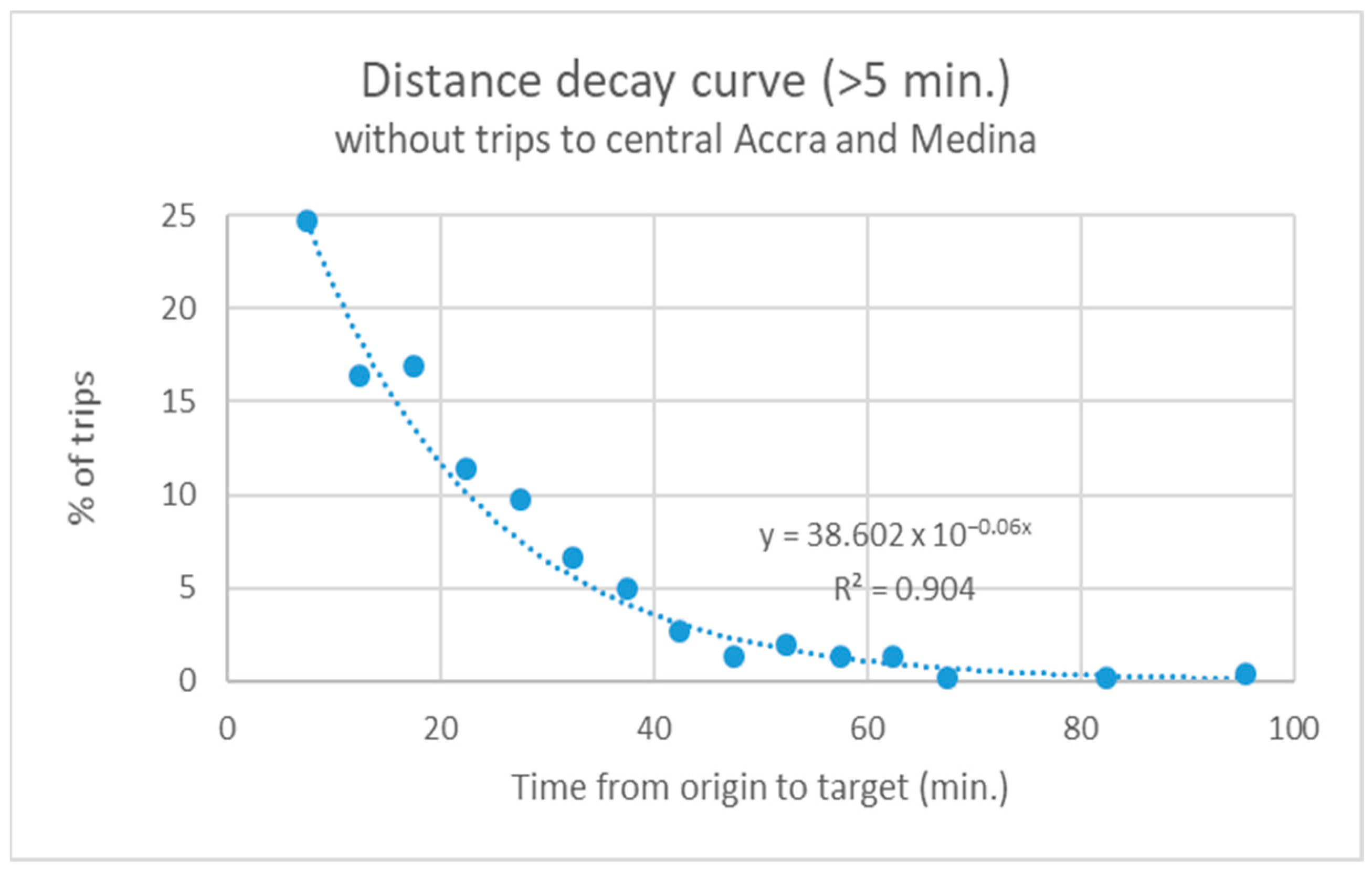
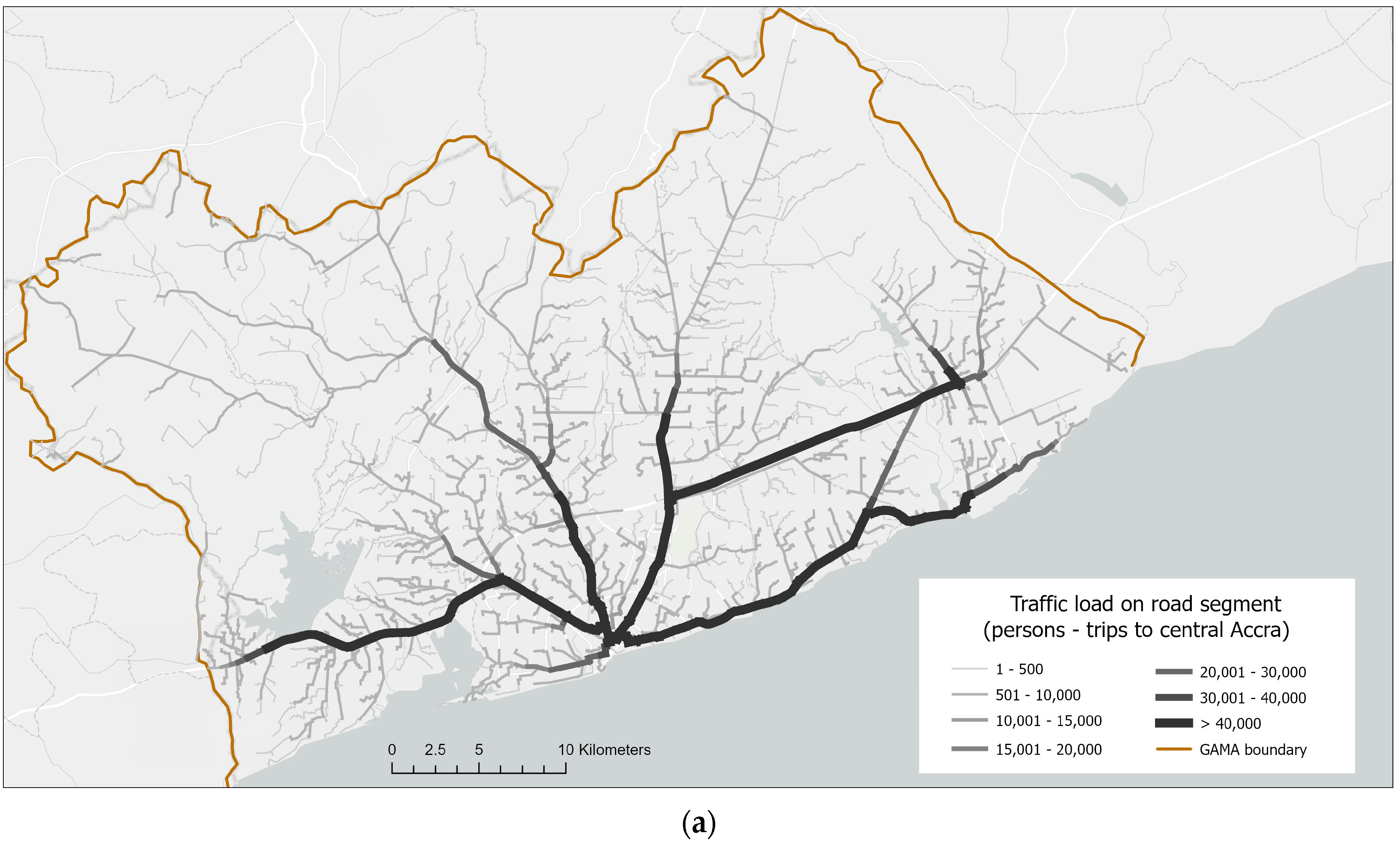

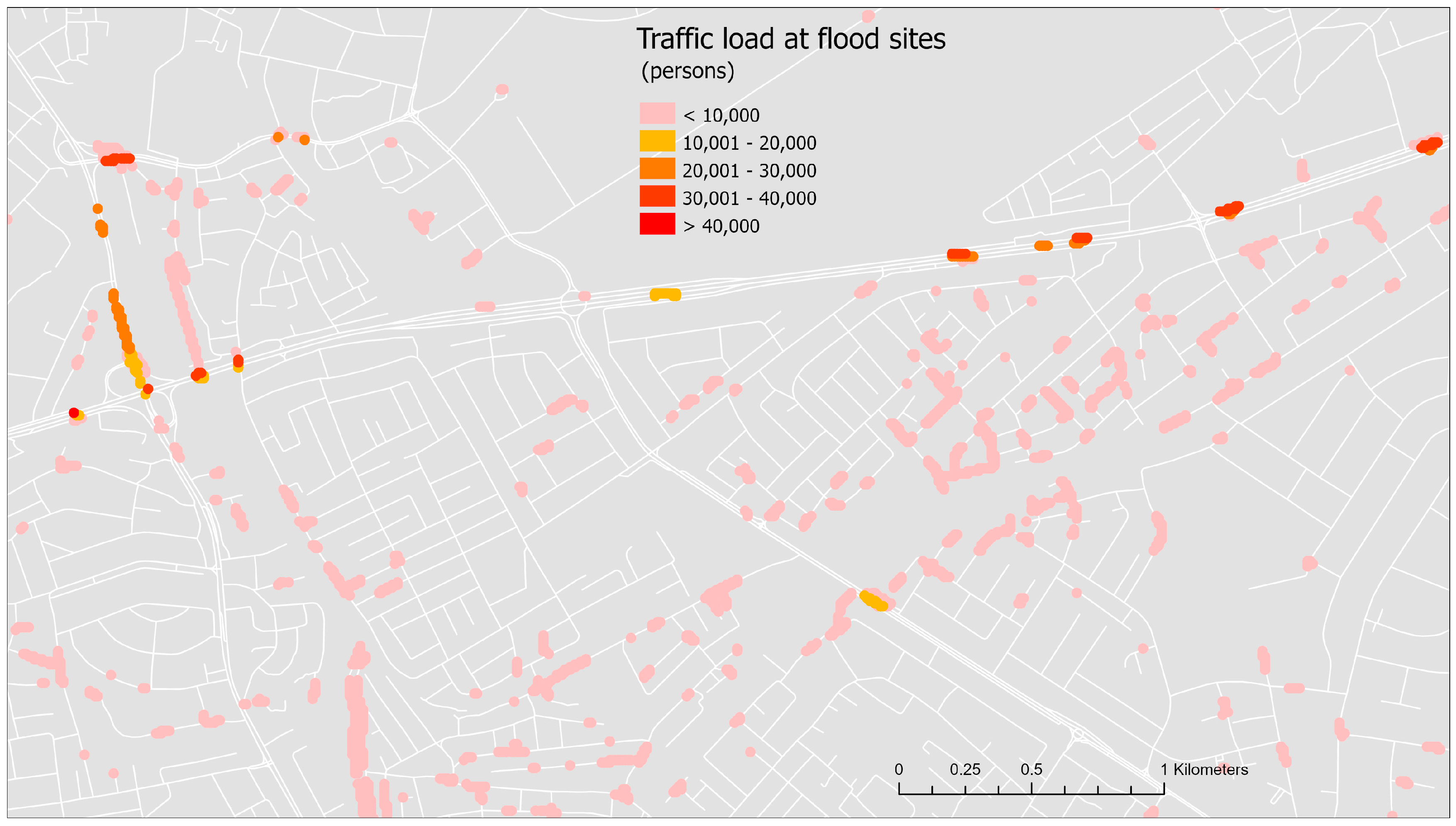
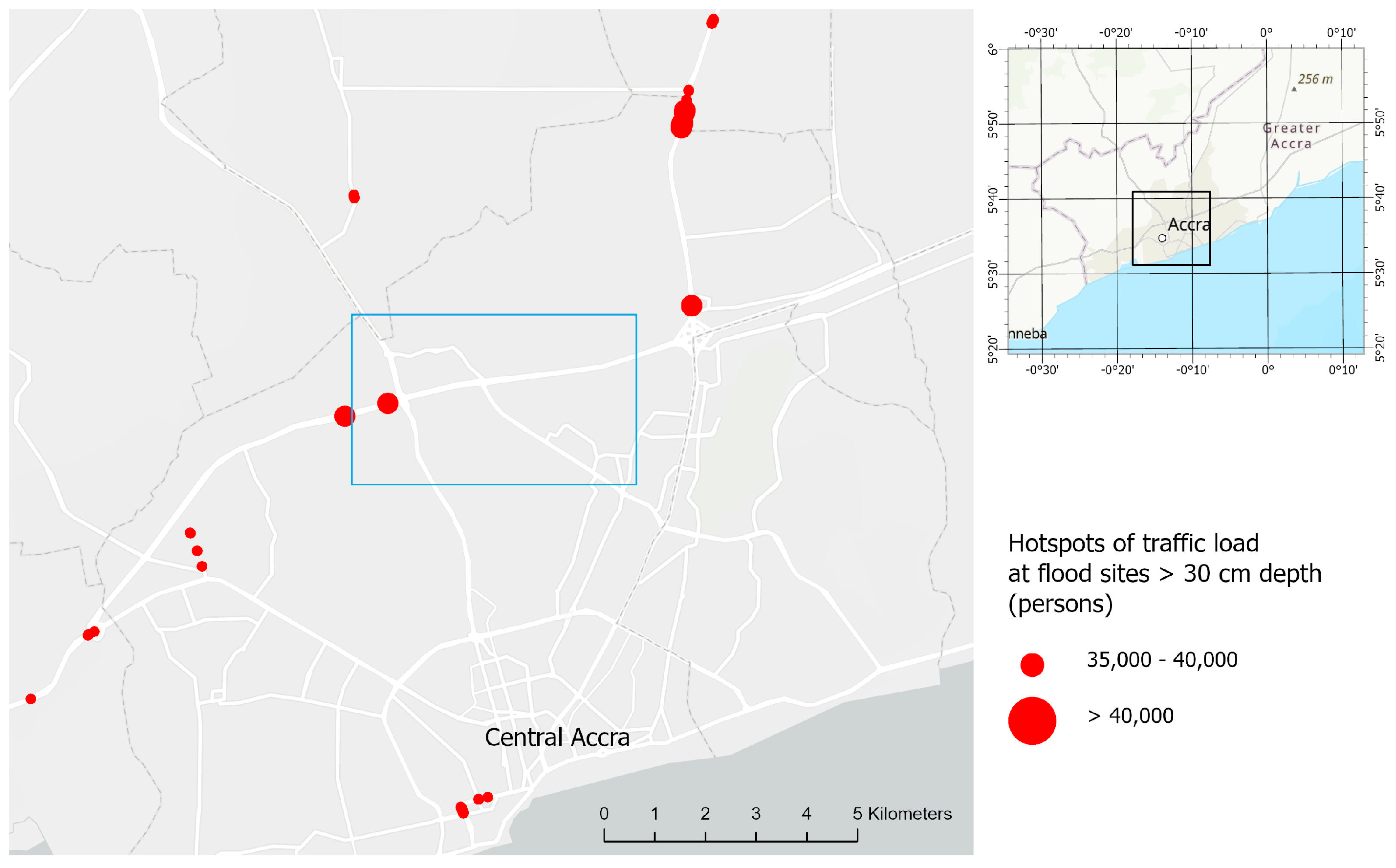
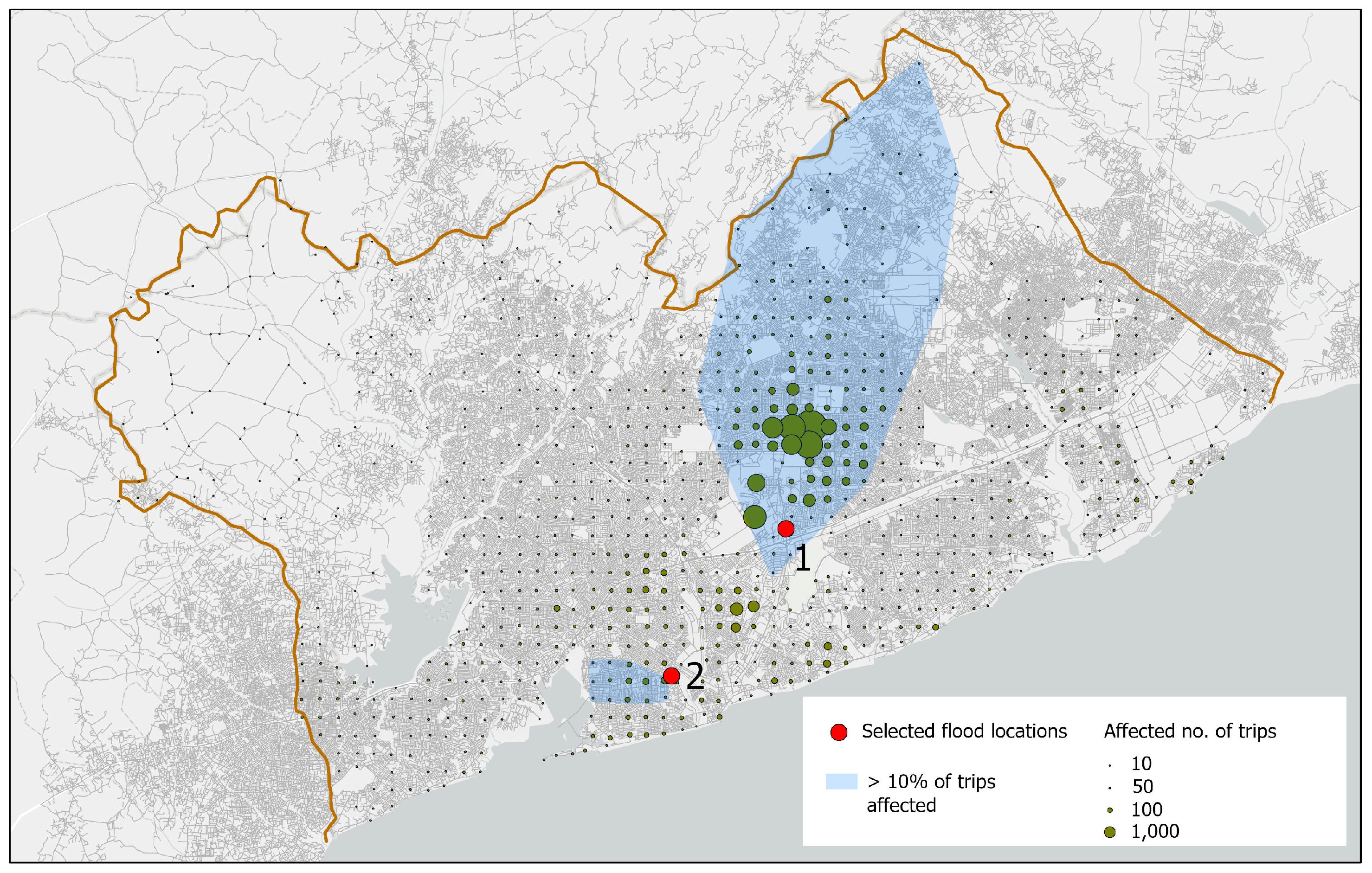
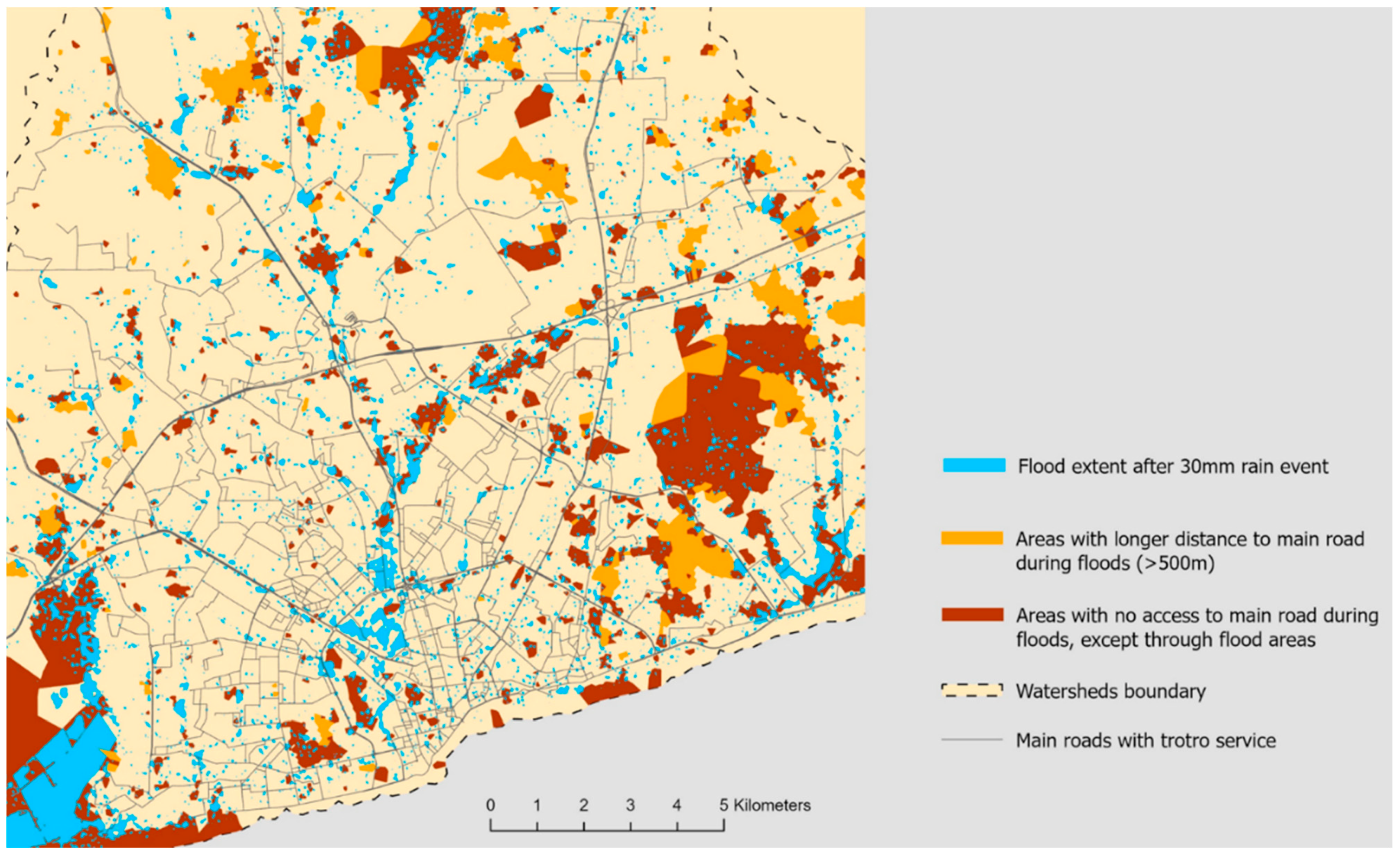

| City Scale (A) | Local Scale (B) | |
|---|---|---|
| Hotspots causing mobility loss | A1. Flood-prone locations (*) overlapping roads with high modelled traffic volumes | B1. Flood-prone locations (*) overlapping interior roads that support a high number of routes towards main roads (**) |
| Method: A transport model is established based on mobility survey data and inter-sected with a map of flood-prone areas | Method: Computation of betweenness centrality of flood-prone network nodes, restricted to routes between B2 hotspots and nearest main road | |
| Areas affected by mobility loss | A2. City areas most affected by flooding at A1 hotspots | B2. City areas most affected in terms of reduced access to main roads during flood events |
| Method: Commuter routes are analyzed to provide the potential spatial impact of floods at specific locations as well as the size of the impacted population | Method: Network analysis (closest facility) in flood and no-flood situations is applied to calculate the relative and absolute mobility loss for each network node. Flood areas act as absolute barriers |
| Santa Maria | Glefe | Adenta | Pokuase | ||
|---|---|---|---|---|---|
| 1 | 2 | 3 | 4 | All | |
| Number of HHs interviewed | 311 | 112 | 316 | 314 | 1053 |
| HH mean size (adults) | 2.66 | 2.6 | 2.84 | 2.3 | 2.6 |
| HH mean size (adults + children < 18) | 4.16 | 4.68 | 4.59 | 3.94 | 4.3 |
| Mobile persons inside GAMA * | 542 | 207 | 586 | 509 | 1844 |
| Mobile persons in all households (%) ** | 36.78 |
Disclaimer/Publisher’s Note: The statements, opinions and data contained in all publications are solely those of the individual author(s) and contributor(s) and not of MDPI and/or the editor(s). MDPI and/or the editor(s) disclaim responsibility for any injury to people or property resulting from any ideas, methods, instructions or products referred to in the content. |
© 2023 by the authors. Licensee MDPI, Basel, Switzerland. This article is an open access article distributed under the terms and conditions of the Creative Commons Attribution (CC BY) license (https://creativecommons.org/licenses/by/4.0/).
Share and Cite
Moller-Jensen, L.; Allotey, A.N.M.; Kofie, R.Y.; Yiran, G.A.B. How Does Flooding Influence Intra-Urban Mobility? The Case of Accra. Sustainability 2023, 15, 14997. https://doi.org/10.3390/su152014997
Moller-Jensen L, Allotey ANM, Kofie RY, Yiran GAB. How Does Flooding Influence Intra-Urban Mobility? The Case of Accra. Sustainability. 2023; 15(20):14997. https://doi.org/10.3390/su152014997
Chicago/Turabian StyleMoller-Jensen, Lasse, Albert N. M. Allotey, Richard Y. Kofie, and Gerald A. B. Yiran. 2023. "How Does Flooding Influence Intra-Urban Mobility? The Case of Accra" Sustainability 15, no. 20: 14997. https://doi.org/10.3390/su152014997





